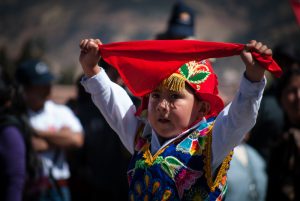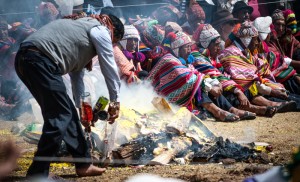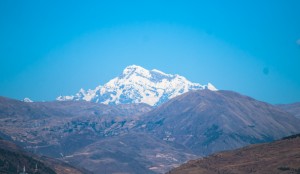Greetings Take Time and Attention (Part III of III on Saludos)

Not only do people send saludos to each other, giving a saludo in the form of regards and greeting is important in day to day affairs. If you spend time in Cuzco, you will notice that people pay more attention to greetings than we tend to in English. They are a daily ritual that requires attention to detail lest you offend people.
One of the worst things you can do is walk by someone you know without saying hello. You do not only have to wave your hand, or just say “hi” in passing, you should show your regards, your affection and view of the other through the warmth and detail of the saludo.
As a result, it takes time to say hi. And as part of that hello you will also recognize that people have ayni, they are part of sets of relationships that extend outward from them and clothe them in being moral, valuable persons. To do this you will ask about their family and friends, especially by name if you know them. Since they may give a perfunctory response, “todo normal”–everything is well–the asking is the important thing.
They will also ask about your family and friends, most likely. This means that a greeting should be much more than a mere hello, and even than a regard. In your gaze and affect you include their significant others as part of what you see and esteem. And, this takes time.
You will also wish them, as well as their people, well and will tell them to take care of themselves. As you may include an abrazo, a hug, in your greeting, you will also send hugs–abrazos–to their loved ones.


This kind of detail is not only required in your interaction with other people, and a subtle measure of your well being and you concern for the people you engage with, it is also part of how you interact with other beings. These include your community, your city, your state, your nation, and the mountains and earth around you.
Just as people take the time to greet each other, so they also will appear in the Plaza de Armas, the main square, during important moments of the festive cycle to “saludar” Cuzco and its authorities.
This saludo may be marching as part of the social bodies–the schools, businesses, and other institutions that compose it– or it may be dancing in organized, costumed troupes which also reproduce the significant groups of the city.
In the dances people perform formalized actions, dances, that demonstrate or represent, key actions of the city’s life, actions that are esteemed or taken seriously. If nothing else they show the city an the region’s culture as a set of representative forms.
The seriousness with which you carry this off, the order and quality of performance is a sign of how much you esteem Cuzco, that whole which is constantly being made by the interaction of the people who compose it.

Similarly, people give saludos to the Pachamama, the mother earth. Indeed she is part of most social events. When you take a drink of chicha or beer you are expected in ordinary society to offer the first drops, either by pouring them or by flicking them with your fingers, to her. For this you make an invocation saying “for the Pachamama.”
But you do not only greet the Pachamama, you also are expected to greet the apus–the important mountains and hills, and show regard for them.
You do this by making what Tom Abercrombie called “libations”. You also recognize all of them, often by name, when flick your beer or chicha into the air, especially on formal, ritual occasions. One by one you flick for them.
When you make a despacho, or a “payment”, an offering to the earth, you also share it with the apus by blowing coca to them, one by one, and by mentioning them and remembering them in the composition of the offering. They are always present.

Abercrombie notes that in this remembering through libation, people are remembering the key histories of their past and, hence the framework of their future. Though expressed in a brief form, “for Ausangate”, for example (Ausangate is the large, snow-clad mountain at one end of the Huatanay Valley, the Valley containing the city of Cuzco), in this case the saludo carries the regard of the people in its performance.
The saludo, in sum, although very difficult to translate into English, is key to life in Cuzco. It provides an opening into understanding the nature of the person as people experience themselves, the nature of groups, and an understanding of the universe. It is very important indeed.




